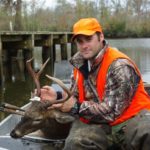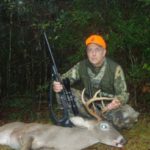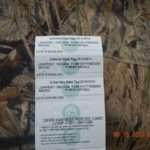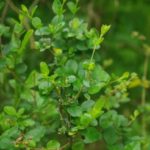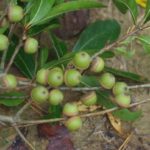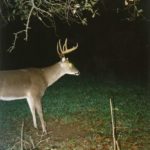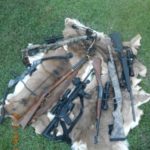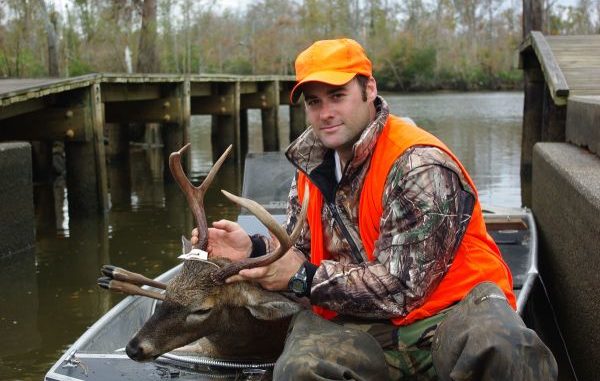
Technology is nice, but utilizing basic woodsmanship is still the key to consistent success. Here’s how to get the job done — using skills our fathers mastered.
On the cover of the 1942 issue of Field and Stream is a picture of a deer hunter who has suddenly encountered a great buck, presumably after having stalked deer for hours in the snow.
It is a glimpse into another era, emphasizing a fundamental approach of chasing game and the ultimate thrill of success.
Boy, has hunting changed over the last 70 years.
If you are a serious deer hunter like me, Louisiana Sportsman is just one many magazines you read, and some deal only with deer hunting. Deer management is a year-round proposition and it’s fun and educational to see what is going on across the country regarding white-tailed deer.
But as you turn the pages, you can’t help but notice the changes between the 1940s and the present. Stories, and well as the advertising, clearly show that deer hunting now is a billion-dollar industry driven by technology. Here is a sample of products, some with their promises, pushed on the pages of one magazine:
• Scent control that suppresses the growth of odor causing bacteria
• Deer estrous spray with an internal bladder compression to create quiet, consistent spray
• Scrape lures that take scrape hunting to a new level
• Scrape dripper to condition bucks to visit scrapes during daytime hours
• Pre-orbital gland lure “for the licking branch”
• Clear shot calibrators
• Hi-tech dynamic arrow spines
• Shot noise stabilizers
• Retina-advanced low light sensitivity scouting cameras
• Time-lapse cameras “to pinpoint travel patterns”
• Internal timer switch in a lighted nock
• Grunt calls that redirects grunts and keeps it on the ground
• German engineered optics
• Silent flight broadheads “with bone crushing penetration”
• Wireless trail camera imaging
• Broadheads with aerodynamic hybrid tips “creating surgical-like precision”
• Carbon technology arrows
• Treestand buddy for hang-on treestands
• Record book targets “for the serious hunter”
That was just the first third of the 144-page magazine, so you can see the point. Technology has indeed taken over the sport of deer hunting.
But, is all of this necessary? Do we really need trail cameras to help us pinpoint deer movement? Can we kill deer with the old school methods, like reading deer sign and setting up to intercept them?
While technology is useful, can we just go back to the basics of deer hunting and still have success, spending a little (or a lot) less money and enjoying the challenge of man against beast?
I think we can, and the way to start is looking at six basics of deer hunting that are true for beginners and veteran deer slayers.
Why do you hunt deer?
It might sound like a stupid question but it could save you a whole lot of start-up money. If all you want to do is just make a deer hunt and maybe kill a deer just so you can “check it off your bucket list,” then this is quite simple to accomplish.
Ask a friend that deer hunts to take you hunting, and find one that will let you use all his gear and firearms. Last season the son of a friend of mine was taking his girlfriend deer hunting so they could kill a deer and then post their photo of it on Facebook or Twitter, like all their friends were doing. Any reason that puts people in the woods chasing game is a good thing for hunting, but it probably does not produce lifetime hunters, which is what the sport really needs.
The reality is that you can make a deer hunt and spend little or no money, and if your friend is a good hunter you just might kill a deer. Your investment is minimal and you would have accomplished your goal.
Now if you really want to kill a big buck and get some antlers to hang on the wall, then you should be a little more serious and contact an outfitter. Book a guided hunt and go get your deer. You could still borrow the gear and firearms and keep costs down somewhat, but you probably should expect to pay around $1,000 or more for the hunt itself. If you want a really big trophy and enjoy the time in a first class lodge, then the cost would be greater.
But, hopefully, you want to try deer hunting to develop a lifetime sport that will give you quality time in the outdoors.
One of the reasons I hunt is for the adventure. Being out in the outdoors, in the woods and fields or on the water has always been adventure for me, especially deer hunting. Getting in the woods, looking for the sign and determining what the deer are doing present challenges.
The day I no longer find that an adventure is the day I will stop hunting.
If developing a long-term passion is your goal, then prepare to make an investment. That does not mean you have to buy all the equipment and technology, but you will need some basic deer hunting gear. You will also need some basic information about the animal you are going to hunt along with knowledge of the rules and regulations for deer hunting.
Know the legalities
Louisiana Wildlife and Fisheries publishes its annual hunting regulations for the coming season. This year the department spent $60,918 to print 300,000 copies of the booklet, and every hunter should have one.
Staying abreast of the rules, regulations and seasons will help you avoid trouble should you get checked while hunting in the field. Knowing the season dates will also help you decide whether you need to get a deer lease or if the public lands provide enough opportunity for your deer hunting.
Louisiana has a long deer season on private lands, but there is also good opportunity on the public wildlife management areas. The state has a large chunk of national forest lands and national wildlife refuges, but the seasons and regulations differs from private land.
Knowing the regulations for legal weapons for deer hunting on your choice of hunting spots will help you to decide what weapon(s) to purchase. New hunters should decide on one type of weapon. As years pass, it is likely they will add to their arsenal. I am a good example
Years ago, in the 80s, when the Tensas Refuge set a muzzleloader season ahead of the gun season, my friends and I invested in muzzle-loaders and enjoyed some nice “Rendezvous” deer hunts. I enjoyed the aspect of black powder firearms and I continued to hunt with my muzzle-loader during the regular deer season, eventually harvesting a buck that qualified for the National Muzzleloader Record Book.
In addition to rules and regulations, deer hunters must learn safe hunting practices, and refresh that knowledge annually. Deer hunting involves powerful weapons, many of which shoot long distances. All are lethal to non-target creatures, including other hunters.
Many regulations are designed to get hunting safe. These include mandatory use of hunters orange clothing and tree-stand fall restraint systems. The safety equipment developed by technology is worth the money if it is used properly and prevents an accident.
Knowing the rules and regulations will also give you information concerning other necessary gear for deer hunting. On private land, a hunters orange hat is required, but when deer hunting on public land hunters need the orange hat and an orange vest.
Of course you will need the proper licenses and deer tags. If you hunt deer just with a gun you will need a basic and big game license as well as the deer tags.
If you hunt with a bow you will need the basic, big game and a bow license along with the tags.
If you hunt with a primitive firearm, you will need the basic, big game and primitive license as well as the deer tags.
If you hunt on the wildlife management areas you will need a WMA hunting permit.
Reading the LDWF’s 2014-15 Louisiana Hunting Regulations, and learn the rules for both public and private lands.
Learn deer biology and behavior
It is important to know your prey. Google “white-tailed deer” and you will get a plethora of information.
Know that while the biology and basic behavior of deer will be the same nationwide, habitat is different and causes variations in deer behavior. Concentrate your study on deer in Louisiana, and book Louisiana Whitetails, which is available from Louisiana Sportsman is a good place to start. LDWF also has literature concerning deer and deer habitat. Focus on the two most important aspects of deer behavior important to hunters — feeding and breeding.
The literature will give you info about the important deer foods in Louisiana, but it’s a good idea to talk with the LDWF biologists for specifics about the deer habitat in the area where you will be hunting. This is especially true for hunting public lands, like state WMAs or federal forest and wildlife refuges.
Deer hunting takes place in the fall and winter, so learn what foods deer are eating at these times. Hard mast like acorns are important food sources, and biologists can tell you what oak trees are present in your area.
Mast crops vary from year to year; white oak trees produce flower and produce acorns in one year while the red oak trees require two growing seasons to produce an acorn. The oak tree composition in the river bottom areas is different from the pine forests in the upland areas. You also would want to know about persimmon trees and other soft mast fruits that deer eat during the hunting season.
Feeding or baiting deer is legal on private lands, but not allowed on public land. If you are hunting on private land, biologists can help you plan food plots recommendations of what forages are best to plant.
Understanding signs associated with deer feeding is a good way to find sites where deer feed on a daily basis. Learn to identify deer droppings and browsed-over plants. If you can spot an oak tree dropping acorns on the ground with deer droppings (pellets) in small piles, you have a place to set up a stand and hunt.
It is not by coincidence that deer hunting season coincides with deer breeding season, a.k.a. “the rut.” Learning the breeding schedule and identifying breeding can increase success. The breeding season varies around the state, and, again, biologists are valuable assets. They can provide specifics about the rut in an area.
Hunting deer signs associated with the rut is important. Bucks leave their signatures for does to find, and you can intercept those messages. Rubs and scrapes let you know bucks are in the woods and are on the lookout for does. Bucks create rubs by “rubbing” antlers on small trees. They create scrapes by pawing at the ground, clearing a small spot to mark with their urine. Limbs and twigs above those rubs are marked with scent from a buck’s orbital glands.
Scrapes are a buck’s calling card during the rut, and it is a part of hunting where a lot of technology has been directed. Hunters spend a lot of money on attractants and lures to build mock scrapes to get an edge.
Truth is, hunters can have success without them. Understanding deer movement associated with these scrapes and rubs can help you locate a stand location where a buck can be intercepted the old fashioned way.
Always remember that a deer’s No. 1 defense mechanism is its sense of smell. Whitetails have excellent hearing and good vision, but you can fool their ears and their eyes. Beating their nose is never easy, since one whiff of human scent, even from a foot print left hours before, is usually enough to send one running.
Playing the wind is critical in stand selection, as well as in stalking.
Most deer hunters hunt from elevated stands, and it is an excellent and safe technique. Stalking can also help you fill a tag, just pay attention to the wind direction and be slow with your movements.
Again, safe hunting is a priority in this situation, particularly on public lands.
Where to hunt
Louisiana has good deer populations in most areas, but obviously some habitats support more deer than others and some habitats will also grow larger bucks.
Remember, your reason for deer hunting, as well as your level of participation, will dictate where you are going to hunt. As a deer hunter and landowner, I find much satisfaction with managing and hunting deer on my land. Many landowners in work hard to develop quality deer populations and excellent hunting opportunities. If you cannot afford to buy a piece of the deer landscape then consider leasing land or joining an established deer club.
There are many stories about crazy hunters on public land, but most of them are simply stories. Public lands are just as safe as private lands.
Some days on public lands are more crowded than others, such as the either-sex days when antlerless (doe) deer are legal. Those times provide hunters their best opportunity to connect with a deer.
The LDWF resources, biologists and literature, can point to the parishes with the best deer populations, as well as the public areas that have good deer populations.
Not only do these public lands have deer, many of them can grow trophy deer.
Necessary equipment
Lots of hard-earned money can be spent on purchasing deer hunting equipment, but most of it is unnecessary. The primary purchase would be the weapon.
Bows, rifles, shotguns and crossbows all kill deer when used properly. Having a full understanding of the weapon being used is critical, and the best route to that is practice.
Shoot.
Shoot more often.
Shoot all the time.
Shoot as much as possible.
Get it? Success always comes down to one shot, and being able to make that shot count will guarantee a filled tag.
Most deer hunting is done from an elevated stand. The old ladder stand is the basic deer stand, but it has one limitation — once it’s built, it stays put. Most camps have dozens of stands, put in traditional locations that have produced.
On public land, and often on private land, permanent stands are not practical. That’s when a climbing stand might be best. Climbers allow you to set up on deer signs, and can help you play the wind.
Safety is always the most important factor with any stand, but especially with a climbing stand. Proficiency is important, and fall-restraint systems should always be worn while hunting from any kind of elevated, exposed stand.
Success is attainable from the ground. Pick a site with good visibility of areas where signs of deer activity are plentiful, and play the wind. Portable ground blinds are available and are especially beneficial when hunting with children. Technology has provided blinds can be easily and quickly erected, and offer some degree of protection from the elements.
On private lands, sitting in a warm closed-in box stand does have its benefits, and well-built boxes can last for many seasons.
Other basic equipment that could be considered necessities are a good compass/ GPS (smart phones usually offer both) and a good pair of binoculars. The latter is not only an important asset, but also provides entertainment. I often use mine to watch birds and other wildlife to pass the time.
New hunters should start with those basics and then add more as they increase their hunting and level of participation.
After the hunt
Most people who hunt small game would be capable of cleaning a deer once it hits the ground, but it’s still a good idea to study how it is done. If possible, find an experienced deer hunter to help.
Once a deer is skinned and gutted, be prepared to make this valuable food source ready for the table or freezer. Established processors can cut, prepare and package the meet for you. Venison is excellent table fare, rich in protein, low in fat and high in nutritional value. If by chance you do not want or need all the venison taken, consider contributing it to charities, like the Hunters for the Hungry Program and share with others who have needs.
An oft-overlooked post-hunt practice is documenting the experience. A camera is a nice piece of equipment to have, and thanks to modern technology, most hunters already have one with them. In addition to being a safety line, most cell phones include a high-resolution camera.
That’s why, of all the equipment provided through modern technology, the cell phone is one accessory that is good to have, especially from the standpoint of safety and being able to communicate with others.
However, when you are on the deer stand and trying to recreate yourself during the hunt, turn the phone off. You can always go back and read your messages.
Keep it simple, stupid
The old KISS formula definitely has application for deer hunting.
We may live in a world of technology, but does it really increase our level of enjoyment when we are hunting. It certainly can make our pocket book lighter.
The fact is we can go back to the simple basics of deer hunting. My most memorable hunts have been those where I searched the woods for deer activity, examined the signs, chose a set-up based upon what I gleaned from nature, and connected with a deer.
Old-school deer hunting does work and can be quite enjoyable.
